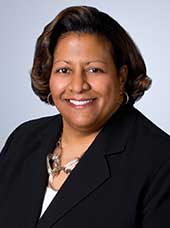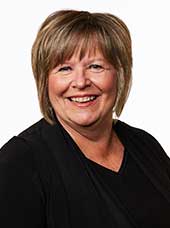10 minutes
These three women didn’t initially dream of credit union volunteerism, but today they’re all board chairs and champions of the CU movement.
Joan Nelson had never thought about becoming a credit union board member, let alone a chair, until a colleague told her she'd be perfect for it. The same is true of Gloria Wilson. And Lesli Malegus, CCD, only considered serving after an employee at her credit union suggested it.
You might find that hard to believe after hearing these women passionately discuss not only why they took the advice to volunteer, but how they ran with their leadership roles—all the way to the chair’s seat of their respective CU boards.
Getting Started
Nelson, Malegus and Wilson didn’t exactly leap into credit union volunteerism as soon as someone pointed out the idea to them.
Nelson in particular had to mull it over a bit first.
It “started out as one of reluctance,” the long-time IBM employee says of her journey onto the board of $2.9 billion Coastal Credit Union in Raleigh, North Carolina. In fact, it took about two years of arm-twisting by her colleague, himself a Coastal CU board member at the time, before she agreed to join the credit union’s supervisory committee in 1993.
“I asked [him] why he had been so persistent,” recalls Nelson, a CUES member. “He mentioned that he felt we needed more diversity in volunteers from both a gender and ethnic perspective.”
Nelson, who is African American, adds “I was touched by his passion and commitment to diversity, so I felt I owed it to him to give it a try.”
It also took a while for Wilson to join the board at Philadelphia-based Ardent Credit Union. Although she’d been a member of what was then known as Sb1 Federal Credit Union for some time, she didn’t consider joining its supervisory committee until a board-member co-worker told her she’d be a good fit for the work it was doing.
“I saw an opportunity to influence member experience through the employees I was introducing to our credit union,” says Wilson, a CUES member, who worked in human resources at SmithKline Corp.—now GlaxoSmithKline or GSK—for 36 years before retiring in 2013. Sb1 FCU’s initial field of membership was GSK employees and their families, but it later added a number of SEGs to its membership base and then switched to a community charter. The CU changed its name to Ardent in 2016. Today, it has more than $690 million in assets and almost 35,000 members.
During those early SEG days, many new hires at GSK were from overseas and “needed to establish U.S. credit, checking and savings accounts to have the ability to make major purchases of homes and cars,” Wilson explains. Some of GSK’s internationally relocating employees and even domestic transfers needed to establish credit, too.
Wilson’s efforts to help those staffers put her in regular contact with the credit union, so when a seat opened on its supervisory committee, she recalled her colleague’s suggestion and threw her hat into the ring. After vetting, she was selected from among several candidates.
Malegus took a somewhat different path to CU volunteerism. She first had to develop an appreciation for what differentiates credit unions from their competitors. Until then, she and her mother, who ran a travel agency together in Selkirk, Manitoba, did all of their banking at one of what Malegus calls the “Big Five.”
After an acquaintance convinced them to move their business to what is now $1.8 billion Sunova Credit Union, also in Selkirk, Malegus got to know the staff members at a local branch well.
“One of them approached me about running for the board” in 2009, she says. “I have always volunteered in the community, so I was intrigued. I saw it as a challenge, because it was unlike any other board I’d been on. … Plus, I thought I might be able to bring some of what I learned by being on the credit union board back to the business I run every day.”

Overcoming Early Challenges
Although Malegus, a CUES member, successfully ran for a seat on the Sunova CU board that very same year, she had to endure a roller-coaster ride before she could get comfortable.
Her first term only lasted one year—instead of the usual three—because she replaced someone who had left the board early. She immediately ran again but lost. Her third time, in 2011, was the charm, as the saying goes. She not only won her seat back on the board, but she’s won every re-election bid since.
Nelson’s early experiences on the Coastal CU board were similarly down-and-then-up. The fact that Nelson was the credit union’s only female board member back when she was first elected in 1996 was at least partially responsible for the initial difficulty.
“At that time, it was a predominantly male environment—a predominantly white male environment,” she says. “That can be intimidating, especially as a minority female. So I had to learn to find my voice. And I would say that was met with mixed reactions and mixed emotions.”
Adding to her woes: “I challenged the norm. I didn’t just accept what was said.”
Nelson says she turned the situation around by leveraging the leadership skills she was developing at her day job. “This included focusing on turning my biggest detractor into an advocate. The key to success there was acknowledging his wisdom and experience, accepting his mentorship and appreciating his guidance.”
She also credits striving to find her voice with allowing her to come into her own as a credit union director and chair. Unsurprisingly, that’s one of the main pieces of advice she aims at other women:
“Don’t be afraid to speak up. Don’t be afraid to lead,” Nelson says. “We bring such valuable perspectives to the table that help not only the organization, but our members as well.”
Diversity of thought is key, she adds, “so it’s important that we share, and that we speak loudly about things that are of importance to us.”
Finding your voice usually isn’t easy, and it rarely happens overnight. So give yourself time, as Malegus did. “When you start a new journey, there are always doubts. Am I good enough? Am I smart enough? What do I have to offer? I still have those doubts, but I am a far more confident and self-assured individual since becoming a board member with Sunova. The opportunity for personal growth is always there, you just have to take it.”
Transitioning to Chair
Wilson’s time on the Sb1 FCU board was comparably free of adversity—until she took over as chair.
Wilson joined the credit union’s supervisory committee in 1987, became the committee chair in 1991 and moved onto the board in 1995. In 2011, the CU’s chair abruptly retired and the vice chair was unable to make the commitment to take over, Wilson recalls. So, she volunteered to fill the seat.
However, there wasn’t much for Wilson or her fellow directors to do. Up to that point, Wilson says, “our former CEO and chair handled most matters, and the rest of us blessed it.” All that changed when the CEO in question retired in 2013 and was replaced by current CEO and CUES member Rob Werner, CIE, who took a more collaborative approach. “He looked to us for guidance and direction, and we weren't prepared to provide it effectively.”
That’s when Wilson’s background in HR came to the fore. She decided the board needed more exposure to the credit union industry in general—and to CU governance and training in particular. Leading by example, Wilson attended the CUES Director Development Seminar in 2014 and followed that up with the Board Chair Development Seminar the following year. She has since gone on to attend such events as Directors Conference, CUES Symposium and various webinars.
Today, Wilson describes herself as a trusted advisor to Werner and a trusted chair to the rest of the board. “We work really well together,” she says, “and I think that’s because we are creating a culture where everyone can voice their opinion and comfortably speak their mind even with opposing viewpoints.”
This sort of open environment was key to Nelson’s and Malegus’ successful ascensions to CU board chair, as well.
“That was scary,” Malegus admits. “I had never chaired anything before.”
She needn’t have worried—her fellow directors welcomed her with open arms. “I got a lot of encouragement, not only from the rest of the board, but from the CEO and the executive team, too,” Malegus says of her first two-year stint as Sunova CU’s chair, which began in 2013. (She started her second term as chair in May 2019.) “They encouraged me to ask questions and made sure I was included in the conversation.
“They also answered pretty much any question I threw at them almost immediately,” she adds.
As for Nelson, she says the now close-knit nature of the Coastal CU board helped ease her into the chair position back in 2012. “We spend a lot of time together—and not just in the boardroom. We also get together socially.
“I think one of the main reasons I was first nominated,” she reflects, “was the strong relationships I’d developed with the other board members by that point.”

Becoming Successful, Effective Chairs
What has kept these three women serving as chair at their respective credit unions since assuming leadership—and what’s helped them become the best board chairs they can be?
Most of their reasons are right in line with what you’d expect: They built strong relationships with their CEOs, they developed trust and credibility with the rest of the board, and they ensured everyone’s voice was heard.
Still, it’s often a lot easier to say such things than do them.
Regarding the chair-CEO relationship, Nelson says to remember that “you don’t always have to agree, but you do have to align to the strategy and mission—because you have to talk with a unified voice to be effective.”
Getting your fellow directors to trust you and find you credible can be an even more difficult task when you first take over as chair. Wilson’s advice: Credibility comes with “being present and prepared at board meetings,” plus being accessible, fair and responsive to individual concerns.
Trust, on the other hand, “comes with keeping confidential matters confidential, understanding the team dynamics, being transparent in decision-making and, maybe more than anything, being motivated by the mission and commitment to the members and work that needs to be done,” she adds.
How do you make sure all voices are heard? Nelson suggests you work to “understand the individual personalities of the board members and then leverage that understanding to ensure everyone is included in the conversation.”
Understanding the personalities sitting around the boardroom table can pay off in other ways, too. The better you do that, Nelson adds, “the easier it is for you to build consensus, and the easier it is to negotiate difficult discussions.”
A key to all of the above, Wilson says, is to be “always asking questions and always listening.”
Malegus has found the second part of that suggestion to be especially beneficial in her time as chair at Sunova CU. “I’m more of a listener than a talker. I prefer to get the opinions of others. I think it is important for a chair—or at least I think it’s important for an effective chair—to listen to others and to try to summarize at the end of the day the opinion of the group.”
Closing Thoughts
Can a single piece of advice sum up each of these women’s experiences as credit union board members and chairs? If so, it would be: Don’t wait for someone to ask you to run. Or maybe: Don’t wait for someone to say you’d be a perfect fit.
“Jump in with both feet,” Malegus says.
If you’re lucky, you’ll be able to look back on your time as a credit union volunteer and say, like Nelson does, “It has forever changed my life.” cues icon
Bryan Ochalla is a former editor of CU Management who writes from Austin, Texas.





